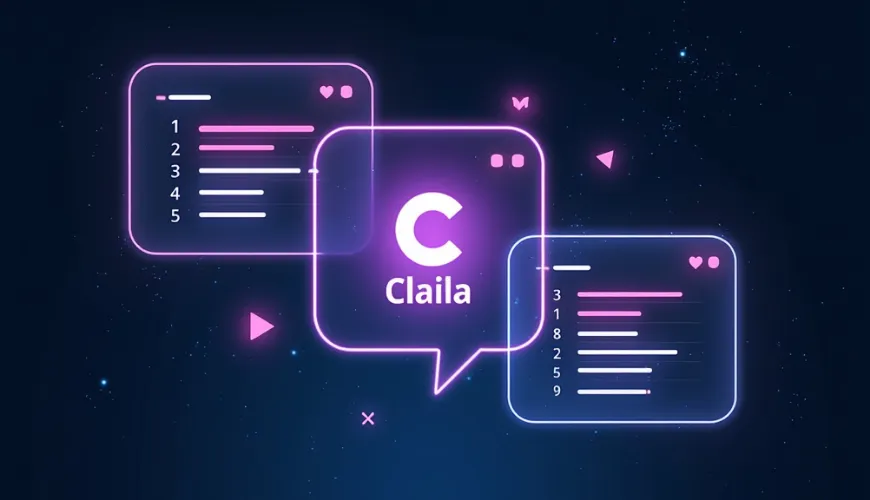Unlocking the Power of Free AI Code Generators: A Complete Guide
Coding no longer requires years of experience or an advanced computer science degree. Thanks to the rise of free AI code generators, anyone—from a beginner to an experienced developer—can write and deploy code more efficiently. These smart tools are powered by advanced language models like ChatGPT, Claude, Mistral, and Grok, and platforms like Claila are making them easily accessible through intuitive chat interfaces.
Whether you're looking to build a Python script, generate HTML/CSS templates, or automate a task, using an AI code generator can help you save time, reduce errors, and even learn programming along the way.
Let's explore how these tools work, why they're changing the game, and how you can get started with the best free AI code generators available today.
Try AI code generator:
What is a Free AI Code Generator?
A free AI code generator is an online tool that uses artificial intelligence—mainly large language models (LLMs)—to automatically write code based on natural language input. Instead of manually typing each line, you simply describe what you want in plain English, and the AI returns functioning code.
For example, you could say:
"Create a Python script that scrapes the latest news headlines from a website."
And the AI will generate a working script using libraries like requests and BeautifulSoup.
These tools are especially helpful for:
- Beginners learning to code,
- Developers seeking quicker prototyping,
- Automating repetitive coding tasks,
- Debugging or improving existing code.
Why AI Code Generators Are a Game Changer
AI code generators revolutionize the development process. Here's why so many developers and hobbyists are turning to them:
Writing boilerplate code or repetitive structures can often become a time-consuming and monotonous task for developers. By leveraging AI, these standard code components can be generated in just seconds, significantly improving time efficiency during development.
For new programmers, AI serves as a valuable learning tool. It provides clear examples of syntax, code structure, and logical flow, helping users grasp programming fundamentals more effectively. This guidance can accelerate the learning process and support skill development through hands-on engagement.
In addition to aiding learning, AI-generated code typically adheres to best practices, which can lead to fewer human errors. The result is cleaner, more reliable code, saving time that might otherwise be spent debugging or refactoring faulty logic.
Another advantage of AI in coding is its support for multiple programming languages, including Python, JavaScript, HTML, SQL, and more. This versatility allows developers to work across different platforms and domains without being limited to a single language, enhancing both learning and productivity.
Meet Claila: Your AI Coding Companion
At the forefront of this innovation is Claila, a platform that integrates top-tier language models like ChatGPT, Claude, Mistral, and Grok into a seamless, user-friendly interface.
Claila allows users to interact with these models through a simple chat format. You type your coding request, and the AI responds with clean, ready-to-use code.
What makes Claila stand out?
- Multiple AI model access: Choose from the best LLMs based on your needs.
- Free to use: No subscription required for basic usage.
- Real-time interaction: Get instant feedback and tweak your code on the fly.
- Supports multiple languages: Python, Java, PHP, JavaScript, HTML/CSS, and more - basically any programming language.
How to Use Claila's Free AI Code Generator
Getting started with Claila is easy and doesn't require any installation or setup. Follow these steps:
- Visit Claila.com
- Choose your preferred AI model (e.g., ChatGPT, Claude).
- Enter your prompt in the chat window.
- Wait a few seconds for the AI to respond with the code.
- Copy, test, and modify as needed.
Example Prompts You Can Try
Here are a few real-life prompts you could use with Claila's AI code generator:
- Prompt: "Write a Python script that renames all files in a folder by adding today's date as a prefix."
- Prompt: "Generate HTML and CSS for a responsive login form."
- Prompt: "Create a JavaScript function that validates email format."
- Prompt: "Build a Python Flask app that displays a random quote from a list."
Sample Output: AI Python Code Generator Free
Let's look at an example using the prompt:
"Write a Python script to check if a number is prime."
Output from Claila's AI chat using ChatGPT model:
def is_prime(n):
if n <= 1:
return False
for i in range(2, int(n**0.5) + 1):
if n % i == 0:
return False
return True
# Example usage
number = int(input("Enter a number: "))
if is_prime(number):
print(f"{number} is a prime number.")
else:
print(f"{number} is not a prime number.")The code is correct, clean, and uses efficient logic. Best of all, it was generated in under 10 seconds.
Best Use Cases for AI Code Generators
AI-generated code is more than a novelty; it has practical applications across various domains. One key advantage is its ability to automate mundane tasks, such as generating scripts for file handling, data processing, or system operations. This frees up time for developers to focus on more complex challenges.
In web development, AI can instantly produce HTML/CSS layouts, forms, and interactive elements, accelerating the prototyping and design process. This helps developers quickly test concepts and refine user interfaces without starting from scratch.
For data analysis, AI-generated code can work seamlessly with Python libraries like pandas, NumPy, and Matplotlib, enabling users to analyze datasets more efficiently. By simplifying data manipulation and visualization, AI helps both beginners and experienced analysts make informed decisions faster.
Another valuable use is in learning and documentation, where AI can comment on code or explain a function's purpose. This encourages better coding practices and helps newcomers understand programming concepts more effectively.
Finally, AI aids in APIs and integration by quickly prototyping RESTful APIs or automating HTTP requests. Developers can experiment with integrations and build functional prototypes in less time, improving overall productivity.
Pitfalls to Watch Out For
While free code generator AI tools can be incredibly helpful, they are not flawless. It's essential to remain cautious and verify the generated output to ensure its accuracy and reliability. One common issue is that AI may produce code that is syntactically correct but logically incorrect. Double-checking the logic of generated code before using it in any project is crucial to avoid unexpected errors or inefficiencies.
Security should always be a top priority when working with AI-generated code. Be particularly cautious with input/output handling, as improper implementation could lead to vulnerabilities like injection attacks. Ensuring the generated code follows best security practices can help prevent potential security breaches.
Another key principle is to fully understand the code before implementing it, especially in production environments. Blindly using AI-generated code without reviewing its functionality and potential consequences can lead to unexpected issues. Take the time to analyze and comprehend how the code works before integrating it into your project.
Finally, be aware of the inherent limitations of AI models. Some may lack context or fail to remember previous queries beyond a single prompt. This limitation means that complex, multi-step coding solutions may not always be consistent across multiple interactions, requiring careful oversight and manual corrections.
Comparing the Best Free AI Code Generators
There are several tools available, but not all are created equal. Claila leads the pack by offering access to multiple models in one place.
Here's a brief comparison of some popular options:
| Tool | Features | Language Support | Free Plan? |
|---|---|---|---|
| Claila | Multiple AI models, chat interface, fast output | Python, JS, HTML, SQL, more | ✅ Yes |
| Replit Ghostwriter | IDE integration, code completion | Multiple | ❌ Limited free tier |
| GitHub Copilot | VS Code plugin, real-time suggestions | Multiple | ❌ Trial only |
| Tabnine | AI code completion | Multiple | ✅ Limited |
| Codeium | Chat + autocomplete | Multiple | ✅ Yes |
Claila's ability to let users select from ChatGPT, Claude, Mistral, or Grok gives it a unique edge, especially when different models perform better in different contexts.
Real-Life Example: Building a Simple To-Do App
Let's walk through a more complex example. Suppose you want to build a basic to-do web app using Flask.
Prompt: "Create a simple Flask app that lets users add and view to-do items stored in memory."
Response from Claila (ChatGPT model):
from flask import Flask, request, render_template_string
app = Flask(__name__)
todos = []
template = """
<!doctype html>
<title>To-Do List</title>
<h1>To-Do List</h1>
<form method="POST">
<input name="item" required>
<input type="submit" value="Add">
</form>
<ul>
{% for todo in todos %}
<li>{{ todo }}</li>
{% endfor %}
</ul>
"""
@app.route("/", methods=["GET", "POST"])
def index():
if request.method == "POST":
item = request.form["item"]
todos.append(item)
return render_template_string(template, todos=todos)
if __name__ == "__main__":
app.run(debug=True)This is fully functional code that you can copy and run immediately. It uses Flask's built-in templating and handles both display and form submission.
How to Get the Most Out of AI Code Generators
To maximize your productivity, consider these tips:
- Be clear and specific: Ambiguous prompts yield weak results. Specify language, functionality, and libraries.
- Use follow-ups: After the initial code, ask for improvements, comments, or error handling.
- Iterate: Treat the AI as your coding assistant. Refine your prompts as you go.
- Ask for explanations: Use the AI to learn by asking it to explain the code it generates.
The Future of Coding Has Arrived
AI-powered code generators are transforming how we think about programming. Whether you're automating a task, learning a new language, or building a full-stack app, tools like Claila make it easier than ever to bring your ideas to life.
As AI models continue to evolve and become more accurate, the barrier to entry for software development will keep getting lower. Platforms like Claila are not just tools—they're learning partners, development accelerators, and creative collaborators.
Explore the future of development today at Claila.com and see what your ideas can become—with just a prompt.



